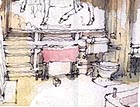Upgrading the bathroom
The best bathrooms find a middle way between the bleakly unimproved and blandly modern, says Ptolemy Dean


One of the most challenging aspects of acquiring an old house is the inevitable upgrading of the bathroom. There are several schools of thought about how bathrooms should be designed. The 'old-fashioned' way can still be found in country houses that have been left unmodernised for half a century or more the bathrooms of my grandmother's house come vividly to mind. The approach was often straightforward; take a room, almost any room, and furnish it with basic white enamelled fittings whose layout would be determined by where 'that man in overalls' said the pipes could go. Heating, such as it was, was rudimentary. There might be a clogged-up old radiator whose 'towel rail' element had long since been disconnected due to leakage, or limescale, or both. Alternatively, there would be one of those dangerous looking hot bar electric heaters, located at some high level and operated by a cord. These were effective at heating the room above head height, but not where the draughts were, at ankle level. The sense of cold would be worsened by a dreary floor of linoleum tiles, curling at the edges. It is no surprise that bathrooms such as these have become unpopular and are being stripped out without a second thought. In their place, increasingly, has come a new style of 'boutique' bathroom. It does not matter whether one finds oneself in New York, Notting Hill or north Norfolk, the approach is exactly the same. Large powerful showers and twin basins are de rigueur, as is, increasingly, a plasma screen built into the wall. Stone floors imported from a distant land reflect the twinkle of numerous recessed halogen spotlights in the ceiling above. These spotlights have become so ubiquitous that it is taken for granted that they must be used. They have become the SUVs of the luminaire world. Punched through ancient lath and plaster ceilings, they generate significant heat in the dusty floor void above, and, along with the inevitable fitted speakers from the hi-fi/television system can be a real intrusion. Obviously, people must have the bathrooms that they want, but when fashions change, as they inevitably will, the original textures of these country-house bathrooms will be irretrievably lost. My favourite bathroom of all time is the one that I have had the pleasure of using at a house in Cornwall. It is of the old school of design, but its guiding principle appears to be that a bathroom should be a civilised room, even if you do have to clean your teeth in it. Handsome panelling gives a head start, meaning that there is no need for those horrid munitions-factory tiles that are so popular. The room is carpeted, giving it warmth, even without the old chrome towel rail. With good proportions and soft, unpretentious lighting, not even the most ordinary of lavatories can detract indeed, its colour matches the white horse whose vast portrait hangs above, apparently quite undisturbed by its setting. This bathroom could only be in an English country house; it could not be anywhere else. Long may it survive to inspire others.
Exquisite houses, the beauty of Nature, and how to get the most from your life, straight to your inbox.
Country Life is unlike any other magazine: the only glossy weekly on the newsstand and the only magazine that has been guest-edited by His Majesty The King not once, but twice. It is a celebration of modern rural life and all its diverse joys and pleasures — that was first published in Queen Victoria's Diamond Jubilee year. Our eclectic mixture of witty and informative content — from the most up-to-date property news and commentary and a coveted glimpse inside some of the UK's best houses and gardens, to gardening, the arts and interior design, written by experts in their field — still cannot be found in print or online, anywhere else.
-
 'My family wore wool at a time when everyone else had cast it off in favour of manmade fabrics': The knitwear pioneer who is one of David Beckham's countryside champions
'My family wore wool at a time when everyone else had cast it off in favour of manmade fabrics': The knitwear pioneer who is one of David Beckham's countryside championsJulie Harding speaks to Rachel Carvell-Spedding the founder of British knitwear brand Navygrey, and one of David Beckham's countryside champions.
By Julie Harding Published
-
 What is everyone talking about this week: Why we love period drama
What is everyone talking about this week: Why we love period dramaObservers cite a need for escapism, but Will Hosie thinks there's more to our enduring love of a period drama.
By Will Hosie Published

